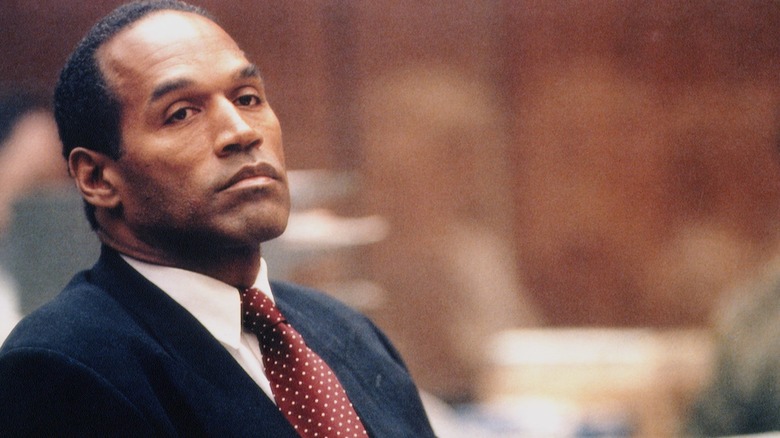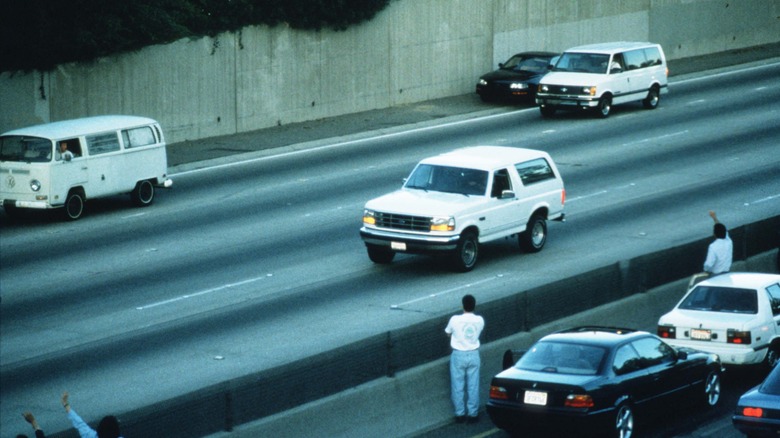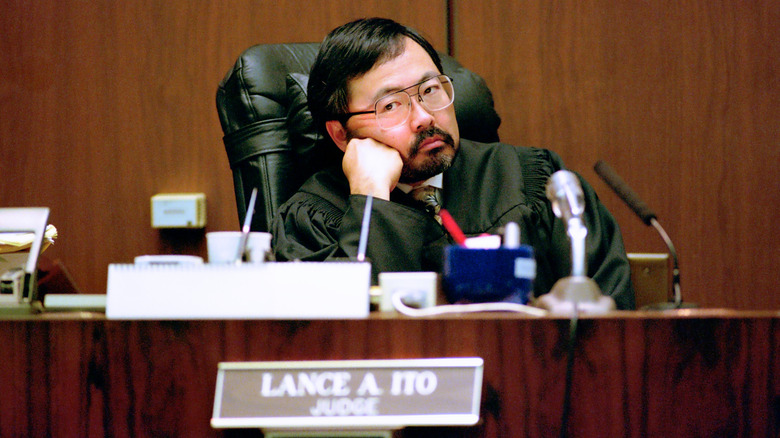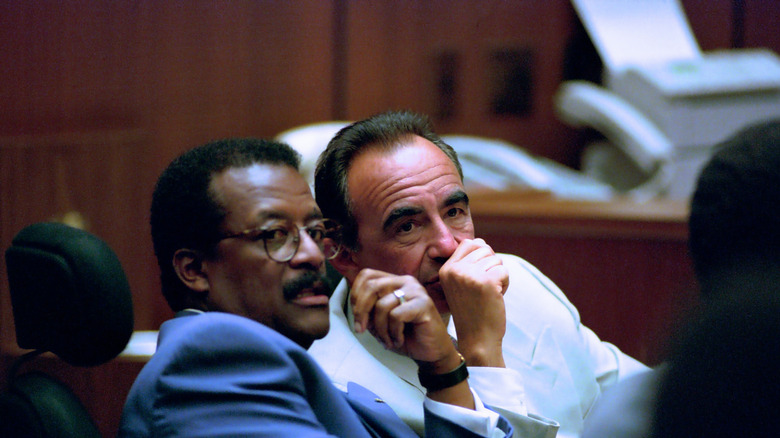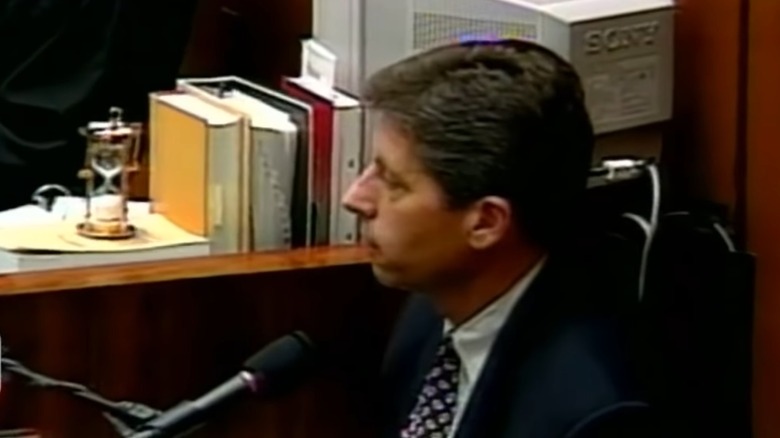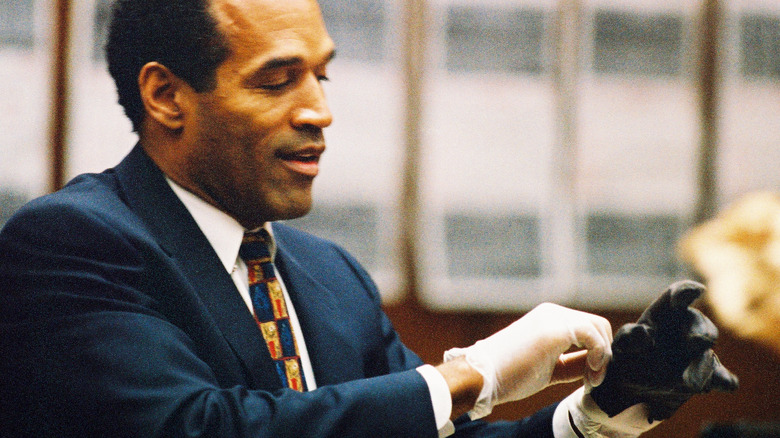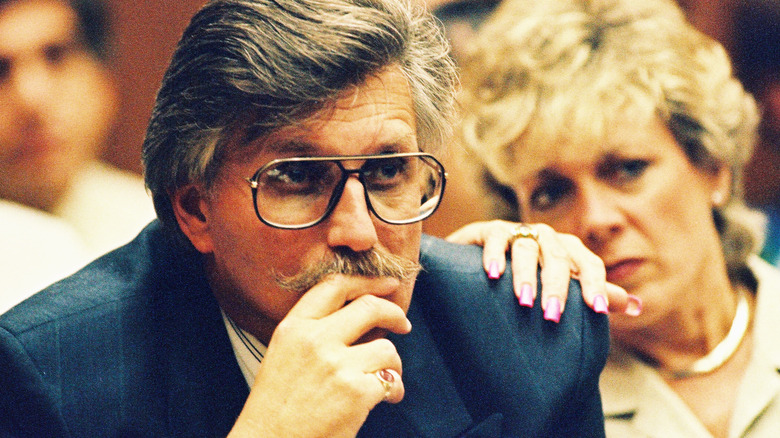The Wild History Of O.J. Simpson's 1995 Murder Trial
In 1994, the chilling murder of Nicole Brown Simpson and her friend Ron Goldman shocked the nation. The pair were found stabbed to death on the driveway of Simpson's Los Angeles home, shortly after midnight on June 13. Within hours, suspicion had fallen upon her estranged husband, O.J. Simpson. The former NFL star was soon accused of killing the pair in a jealous rage, in what became one of the most discussed crimes of the decade. The O.J. Simpson trial had all the elements of a Hollywood drama: a tense car chase, twists and turns as evidence was presented and refuted, and accusations of corruption and police incompetence. And what horrified and captivated America for around 16 months was that everything they saw was real.
The case once again drew the world's attention on April 11, 2024, when news broke that O.J. Simpson had died of prostate cancer at the age of 76, two months after going public that he was dealing with the disease. A post from Simpson's family published on his official X (formerly known as Twitter) account stated: "He was surrounded by his children and grandchildren. During this time of transition, his family asks that you please respect their wishes for privacy and grace."
Other reactions to his death have ranged from muted to gleeful, proving that Simpson remained a divisive figure until the very end. Indeed, his murder trial remains one of the most memorable news stories of the 1990s. But, while many may remember the larger points of the case, some of which have since been cemented into popular culture, the sheer number of mind-boggling details can be staggering to anyone choosing to return to the case in its entirety. Here is the wild history of the so-called "trial of the century."
The car chase
After news of the murder of Nicole Brown Simpson and Ron Goldman made headlines, the story of the case went stratospheric after O.J. Simpson, who was charged with their murder and required to turn himself in to police on June 17, 1994, failed to show. Officers then went to Simpson's LA home, not far from the murder scene — but he had fled. As Larry King told the startled nation on "Larry King Live": "Unbelievably, the most watched, most wondered-about man in America has gone missing tonight. He apparently disappeared from under the noses of his lawyers and doctors this afternoon, dodged an arranged surrender and vanished into the Los Angeles haze."
What happened next was one of the most mesmeric moments in the history of American television. After King went on to explain that Simpson, who was described as armed and dangerous, was now one of America's most wanted men, the broadcaster interrupted his planned discussion to reveal that news helicopters believed they had located Simpson's car on Interstate 5, south of Los Angeles, with a bevy of LAPD cruisers on his tail. Chillingly, it was soon confirmed that Simpson was in the passenger seat, holding a gun to his own head. With police hesitant to pull the vehicle over, the standoff continued for 45 minutes before coming to an end. By then, the broadcast had attracted a record audience of 95 million viewers.
Contact with the car
During that famous Ford Bronco chase in June 1994, the LAPD reportedly believed that a childhood friend and fellow football star, Al Cowlings, was driving O.J. Simpson. Cowlings had previously been in touch with the police to say that he was with Simpson, and that he was going to drive the murder suspect to see his mother, who had gone into hospital that day. The pair was cheered by many members of the public.
Recordings of Cowlings' conversations with police operators would later be released, in which he can be heard begging for police cruisers to back off, suggesting that Simpson was at risk of pulling the trigger of the gun he had held to his own head. Simpson himself also spoke on the phone, speaking frenziedly to police negotiator Tom Lange, to whom he said that he was not attempting to escape, but instead wanted to visit Nicole Brown Simpson's grave. In one moment of high drama, as Lange pleaded with Simpson to throw the firearm out of the window, Simpson said, "I'm just going to leave. I'm just going to go with Nicole. That's all I'm going to do. That's all I'm trying to do" (via CNN).
Fortunately, Lange managed to talk Simpson out of any other rash action, after repeatedly asking Simpson to think about his family and fans who love him. The car eventually arrived at Simpson's mansion, where — in front of a nationwide audience — the NFL star finally handed himself in to the LAPD.
Jury controversies
The looming murder trial of O.J. Simpson became one of the most anticipated public events of the mid-90s. And in the second half of 1994, even before the trial began, tension continued to be ramped up by the elongated jury selection process, which fascinated the millions who were by then raptly following the case, all aided by extensive media coverage.
The intrigue began when it was revealed that Simpson would be tried in downtown Los Angeles, where the prosecution filed their case, instead of Santa Monica, where the murders of Nicole Brown Simpson and Ron Goldman occurred. That decision affected the racial composition of the jury, at a time when reaction to the case was split among race lines; most white Americans believed Simpson was guilty of murder, while most Black Americans believed he was innocent. Because of the sensational nature of the case, presiding Judge Lance Ito (pictured) excluded any jurors who had been exposed to mass media, while the prosecution and defense teams provided queries for a huge questionnaire that potential jurors must answer to reveal any biases one way or another. The process took two months, initially settling on eight Black, two Hispanic, one half-white, half-Native American, and one white juror.
Since the trial, several jurors have spoken publicly about their experiences and their thought processes as the trial progressed, revealing that tensions sometimes ran high. Serving as a juror on the O.J. Simpson trial turned out to be life-changing for many of those involved, and they remained recognizable to many Americans for long afterward.
Celebrity lawyers
Having a bona fide celebrity at the center of a televised double-murder case was almost unprecedented for American television, and with so many eyeballs on the events unfolding in the LA courthouse, others also found themselves made into household names in the process. These included the veteran lawyers who made up O.J. Simpson's defense team, dubbed by the press as the "Dream Team."
At the time, Simpson was a wealthy man, worth many millions thanks to his careers in sports and Hollywood, as well as numerous lucrative sponsorship deals. Consequently, he was able to hire some of the best names in the legal business, such as Robert Shapiro (pictured, right), who was involved in Simpson's surrender and initially led his defense team, F. Lee Bailey, a skilled cross-examiner who later released a book about the case, and Barry Scheck, whose passionate and theatrical performances in court made for compelling viewing during live broadcasts.
All saw their fame increase significantly after the Simpson murder trial, but none was quite so immortalized as Johnnie Cochran, Jr. (pictured, left). Cochran Jr.'s previous fame representing prominent entertainers like Michael Jackson and Tupac Shakur was dwarfed by his involvement in what had become known as the "trial of the century," leading to the growth of his legal practice and immense wealth in his later years.
Solid forensics?
The case against O.J. Simpson rested on what investigators and the prosecution jointly believed was undeniable forensic evidence, all of which would point to his guilt. Forensics experts highlighted drops of blood found at the crime scene, on Simpson's car, and on items of clothing found at the scene and in Simpson's home. When he was arrested, Simpson had a laceration on one of the fingers of his left hand, which criminalists working on the case believed was sustained during the attack. Through analysis, the drops were shown to almost certainly be that of the accused.
But even as evidence was being collected, the publicity of the case affected the investigation, with investigators later admitting that the press intrusion as they worked was a distraction. Simpson's defense team later pounced on what they claimed was evidence of sloppy forensic work, including the contamination of the crime scene, caused by the presence of several people at a time when it should have been cordoned off. The use of a blanket from the house to cover Nicole Brown Simpson's body — to prevent it from being photographed by the press — contributed to their claims.
Just as damning was video evidence that the defense obtained of LAPD criminologist Dennis Fung mishandling evidence, collecting evidence without the use of gloves, and making storage errors that they said invalidated the blood samples — which he was later forced to admit on the witness stand.
Bombshell claims
O.J. Simpson's "Dream Team" defense didn't just cast doubt on the professionalism of investigators at the crime scene, they went much further. In their arguments, they outlined what they saw as the possibility of a police conspiracy to frame O.J. Simpson for the murder of his wife and her male friend. Using the testimony of other forensics experts, they detailed a scenario in which drops of blood were planted at the crime scene intentionally, wiped on a pair of Simpson's socks that were in his home, and possibly applied blood to both the interior and exterior of his car.
During cross-examination by F. Scott Bailey, Simpson's lawyers focused these claims on LAPD detective Mark Fuhrman. Fuhrman was one of the first at the murder scene, and was present when police first went to check on Simpson after the discovery of the bodies of Nicole Brown Simpson and Ron Goldman. He was also the one who discovered a bloody glove behind Simpson's pool house, which would later become a pivotal — and extremely famous — piece of evidence. In one of the most notorious episodes of the trial, the defense team painted Fuhrman as a spiteful racist, and undermined his denials by presenting evidence that he had a history of using slurs against Black people, among other evidence that painted Fuhrman as a corrupt cop.
Furhman's apparent racism was pinpointed as his motive to carry out the framing, which landed like a bombshell with both the press and jury, and remains one of the most shocking and analyzed moments of the case. Fuhrman, who was later proven to have lied in court, was eventually convicted of perjury.
The gloves
Throughout the eleven-month-long O.J. Simpson murder trial, the jury was presented with copious evidence from both the prosecution and the defense, all to try and paint contrasting pictures of the murder of Nicole Brown Simpson and Ron Goldman. But as the trial went on, attention increasingly turned to the bloodied gloves found at the crime scene and Simpson's home, which prosecutors claimed he'd worn as he stabbed Nicole Brown Simpson and Ron Goldman to death. Blood and fibers from both victims, as well as from Simpson, were found on the gloves.
Eventually, the prosecution made the fatal error of having Simpson try the gloves on in the courtroom, and what happened next became perhaps the most famous moment of the trial. The famously athletic 6-foot-1 defendant took up the gloves and attempted to slide them over his fingers ... but they didn't fit. In the defense's closing arguments, Johnny Cochran Jr. famously instructed the jury: "If the gloves don't fit, you must acquit."
Experts attempted to explain how the gloves didn't fit over Simpson's hands. It was claimed that the dried blood on the gloves had caused the gloves to shrink as they thawed in the cold night air. At the same time, the prosecution speculated that the athlete may have intentionally stopped taking prescribed arthritis medication that prevented his hands from swelling, causing the gloves not to quit. Nonetheless, those arguments ultimately didn't convince the jury. On October 3, 1995, as millions in the U.S. and across the globe anxiously watched, the verdict was finally delivered to the court: "Not guilty."
Aftermath of the verdict
The conclusion of O.J. Simpson's murder trial rocked the American people, with experts claiming that it exposed deep societal division and the flaws of the U.S. justice system. The trial took place at a strained moment in terms of race in America — the memory of Rodney King's savage beating by police officers in 1991 was still fresh, and tensions between the Black population of Los Angeles and the city's much-criticized police force were high. Amid the widespread racial discrimination of the age, the jury's findings were hotly contested for years, and the story never really went away.
Expert analysts have continuously discussed the O.J. Simpson murder case over the three decades since its conclusion. Scores of books have been written — including a controversial book by Simpson himself, titled "If I Did It." — and it has remained a regular fixture of true crime programming ever since. While some experts have attempted to pin down exactly how the jury came to its bombshell conclusion that Simpson should walk free, other academics focused on the class disparity regarding public opinions of the ruling, with higher earners significantly more likely to believe the ruling was a miscarriage of justice than low earners.
Even those involved in the case later voiced their dissent: Simpson's own former defense lawyer, Robert Shapiro, was later critical of the "Dream Team" for their racially charged cross-examination of Mark Fuhrman, a decisive point in the trial.
A pop culture phenomenon
The Simpson trial and his subsequent acquittal became a pop culture phenomenon. One of the most memorable reactions to the case was that of the comedian Norm Macdonald, who as anchor of the "Weekend Update" section of "Saturday Night Live" reacted to the historic ruling with the immortal line: "Well, it is finally official. Murder is legal in the state of California" (via The Independent). Such jokes about the Simpson case remained controversial, however, as evidenced by a rumor about the comedian — which turned out to be true – being fired from "SNL" at the behest of a network executive who happened to be a Simpson sympathizer.
Johnny Cochran Jr. also became a pop culture touchstone as the ultimate example of the slick, though morally ambiguous, celebrity lawyer: The year after the trial, a character based on Cochran, Jackie Chiles, a similarly silver-tongued, sharply-dressed attorney, featured on the sitcom Seinfeld and remained a figure until the show's finale.
The civil trial
Nicole Brown Simpson and Ron Goldman's families continued to seek justice after O.J. Simpson's criminal trial. In 1997, they sued O.J. Simpson in civil court for wrongful death, which saw the former NFL star in the dock again. This time, he was found responsible for the deaths, and was ordered to pay the families $33.5 million as a result. While Simpson managed to avoid paying the majority of the restitution during his lifetime, he would be entangled in more legal issues a decade later: In October 2008, he was convicted of several felonies relating to a robbery in Las Vegas, serving nine years behind bars before being released on parole in 2017.
At the time of Simpson's death, Fred Goldman (pictured), the father of Goldman, spoke to The Daily Beast to say that he had never felt any closure over his son's death. The families now stand to receive what they are owed from the dead star's estate.
